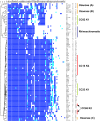Virulent clones of Klebsiella pneumoniae: identification and evolutionary scenario based on genomic and phenotypic characterization
- PMID: 19319196
- PMCID: PMC2656620
- DOI: 10.1371/journal.pone.0004982
Virulent clones of Klebsiella pneumoniae: identification and evolutionary scenario based on genomic and phenotypic characterization
Abstract
Klebsiella pneumoniae is found in the environment and as a harmless commensal, but is also a frequent nosocomial pathogen (causing urinary, respiratory and blood infections) and the agent of specific human infections including Friedländer's pneumonia, rhinoscleroma and the emerging disease pyogenic liver abscess (PLA). The identification and precise definition of virulent clones, i.e. groups of strains with a single ancestor that are associated with particular infections, is critical to understand the evolution of pathogenicity from commensalism and for a better control of infections. We analyzed 235 K. pneumoniae isolates of diverse environmental and clinical origins by multilocus sequence typing, virulence gene content, biochemical and capsular profiling and virulence to mice. Phylogenetic analysis of housekeeping genes clearly defined clones that differ sharply by their clinical source and biological features. First, two clones comprising isolates of capsular type K1, clone CC23(K1) and clone CC82(K1), were strongly associated with PLA and respiratory infection, respectively. Second, only one of the two major disclosed K2 clones was highly virulent to mice. Third, strains associated with the human infections ozena and rhinoscleroma each corresponded to one monomorphic clone. Therefore, K. pneumoniae subsp. ozaenae and K. pneumoniae subsp. rhinoscleromatis should be regarded as virulent clones derived from K. pneumoniae. The lack of strict association of virulent capsular types with clones was explained by horizontal transfer of the cps operon, responsible for the synthesis of the capsular polysaccharide. Finally, the reduction of metabolic versatility observed in clones Rhinoscleromatis, Ozaenae and CC82(K1) indicates an evolutionary process of specialization to a pathogenic lifestyle. In contrast, clone CC23(K1) remains metabolically versatile, suggesting recent acquisition of invasive potential. In conclusion, our results reveal the existence of important virulent clones associated with specific infections and provide an evolutionary framework for research into the links between clones, virulence and other genomic features in K. pneumoniae.
Conflict of interest statement
Figures



References
-
- Ørskov I. The genus Klebsiella (Medical aspects). In: Starr MP, Stolp H, Truper HG, Balows A, Schlegel HG, editors. The Prokaryotes: a handbook on habitats, isolation, and identification of bacteria. Berlin: Springer-Verlag; 1981. pp. 1160–1165.
-
- Seidler RJ. The genus Klebsiella (Nonmedical aspects). In: Starr MP, Stolp H, Truper HG, Balows A, Schlegel HG, editors. The Prokaryotes: a handbook on habitats, isolation, and identification of bacteria. Berlin: Springer-Verlag; 1981. pp. 1166–1172.
-
- Brisse S, Grimont F, Grimont PAD. The genus Klebsiella. In: Dworkin M, Falkow S, Rosenberg E, Schleifer K-H, Stackebrandt E, editors. The Prokaryotes · A Handbook on the Biology of Bacteria. 3rd edition ed. New York: Springer; 2006.
-
- Paterson DL, Ko WC, Von Gottberg A, Mohapatra S, Casellas JM, et al. International prospective study of Klebsiella pneumoniae bacteremia: implications of extended-spectrum beta-lactamase production in nosocomial Infections. Ann Intern Med. 2004;140:26–32. - PubMed
Publication types
MeSH terms
LinkOut - more resources
Full Text Sources
Other Literature Sources
Molecular Biology Databases

